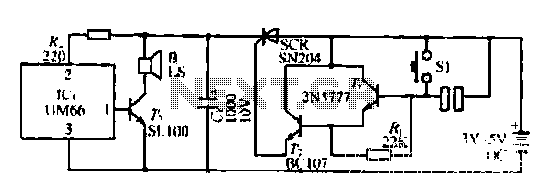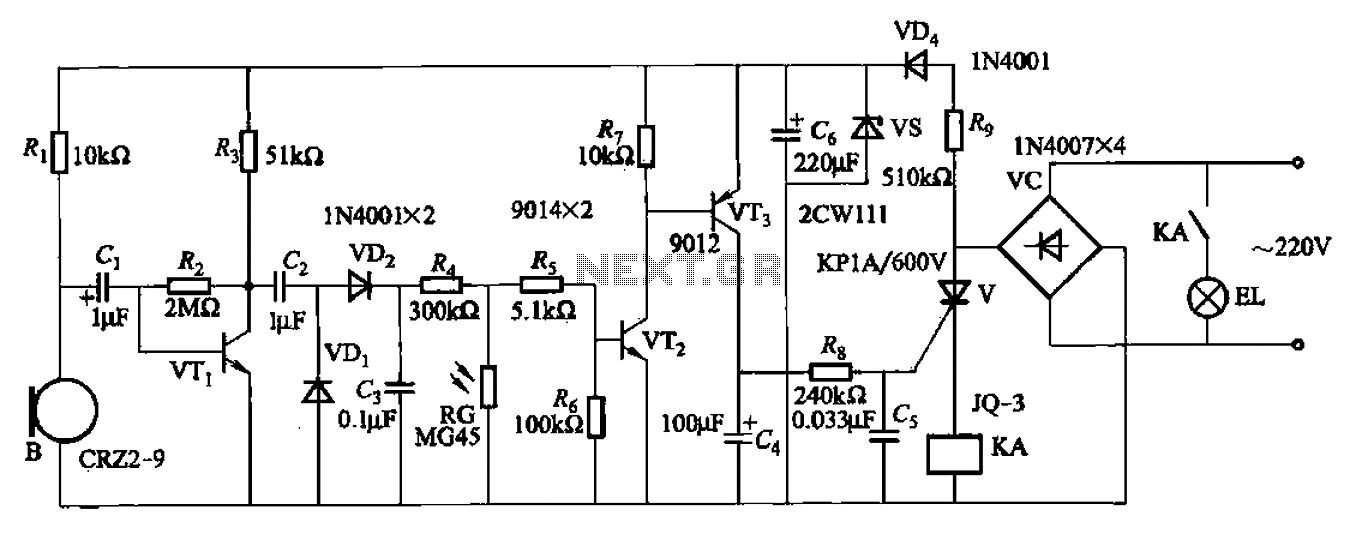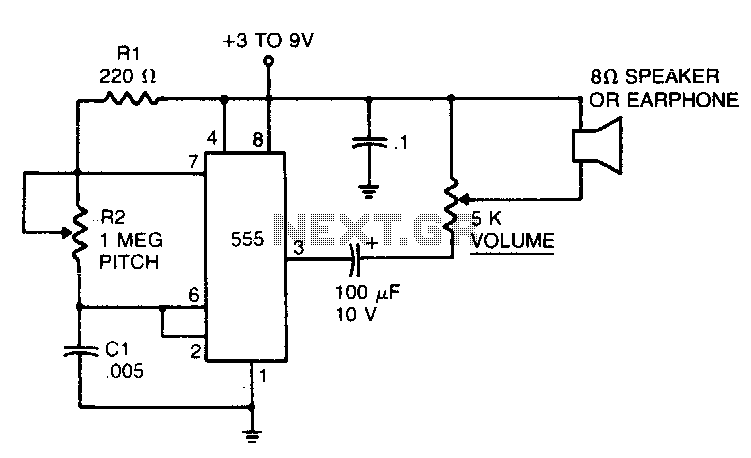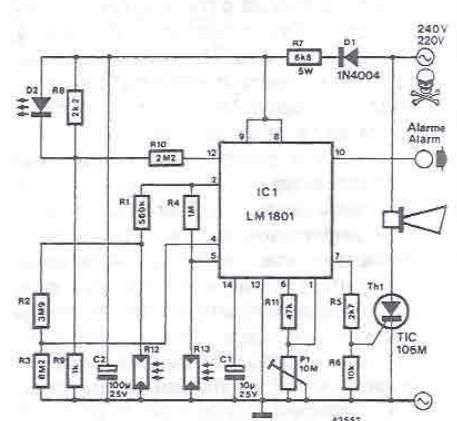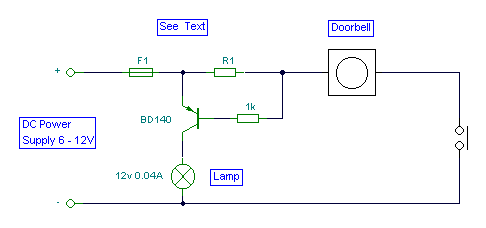
Dynamic mic preamplifier circuit
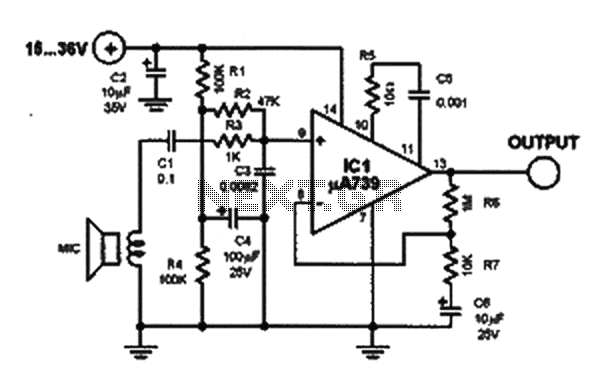
This microphone preamplifier utilizes the low-noise integrated circuit (IC) uA739. It serves as a practical example of designing an effective preamplifier for dynamic microphones. The IC contains two identical integrated preamplifier circuits, with the second preamp functioning in the same manner for the second channel of a stereo microphone. The non-inverting input is biased at approximately 50% of the power supply, achieved through a voltage divider circuit composed of resistors R1 and R4. The junction between R1 and R4 is shared by both channels. High-frequency unwanted signals from the microphone are filtered out using an RC circuit formed by R3 and C4. Frequency compensation is managed through the R7 and C6 circuit, which is specifically designed to prevent oscillation at an amplification level of 100. The input impedance is approximately 47 kΩ, allowing a standard dynamic microphone to connect to a high-impedance preamp, resulting in optimal performance. The output impedance is several hundred ohms, and the maximum peak-to-peak output voltage is slightly lower than the supplied power. The frequency response ranges from 20 Hz to 20 kHz (-3 dB), with an upper cutoff frequency of 80 kHz when the low-pass filter is excluded from the circuit. The uA739 IC can be substituted with TBA231 or SN76131 without altering the external circuit configuration.
This microphone preamplifier circuit is designed to enhance the audio signal captured by dynamic microphones, ensuring high fidelity and low noise levels. The uA739 integrated circuit is chosen for its low noise characteristics, making it ideal for audio applications where clarity is paramount. The dual preamp configuration allows for stereo microphone setups, providing a balanced audio input for both channels.
The voltage divider formed by R1 and R4 ensures that the non-inverting input is properly biased, which is critical for maintaining linearity in the amplifier's response. This biasing technique helps in achieving a stable operating point, which is essential for minimizing distortion in the output signal.
The RC filtering circuit, consisting of R3 and C4, effectively suppresses high-frequency noise that may be picked up by the microphone, thereby enhancing the overall signal quality. Additionally, the frequency compensation circuit formed by R7 and C6 prevents oscillations that could occur at high gain settings. This is particularly important in audio applications where unwanted feedback can lead to undesirable sound artifacts.
With an input impedance of approximately 47 kΩ, the preamp is well-suited for dynamic microphones, which typically have lower output impedances. This impedance matching is crucial for maximizing signal transfer and ensuring that the microphone's output is effectively amplified without loss of quality.
The output impedance of several hundred ohms allows for compatibility with a variety of audio processing equipment, ensuring versatility in different setups. The specified maximum peak-to-peak output voltage indicates that the circuit can handle audio signals without clipping, maintaining the integrity of the sound.
The frequency response of 20 Hz to 20 kHz covers the full range of human hearing, making it suitable for a wide array of audio applications. The optional high cutoff frequency of 80 kHz provides additional flexibility for specialized applications where higher frequencies may be relevant.
The ability to replace the uA739 with other ICs like TBA231 or SN76131 without modifying the external circuit design offers further convenience for engineers and designers, allowing for component substitution based on availability or specific performance characteristics desired. Overall, this microphone preamp design exemplifies a robust solution for high-quality audio signal amplification.This mic preamp uses the low noise IC uA739. The circuit is an example of how a good preamplifier can be designed for dynamic microphones. The IC houses two identical integrated preamp circuits. The second preamp is used in identical manner This mic preamp uses the low noise IC uA739. The circuit is an example of how a good preamplifier ca n be designed for dynamic microphones. The IC houses two identical integrated preamp circuits. The second preamp is used in identical manner for the second channel of the stereo microphone. The non-inverting input is biased at about 50% of the power supply. This bias voltage is set by the voltage divider circuit R1 and R4. The point between R1 and R4 is used commonly for both channels. The unwanted HF signals coming from the microphone are filtered out by the RC-circuit composed of R3/C4. Frequency compensation is done by the R7/C6 circuit. The values of R7 and C6 were designed to avoid oscillation at the amplification level of 100. The input impedance is about 47K. This means that a normal dynamic microphone gets connected to a high impedance preamp which in turn produces good results.
The output impedance is about several hundred ohms. THe maximum peak-peak output voltage is about several volts lower than the supplied power. The frequency range is from 20Hz to 20KHz (-3dB). The upper cutoff frequency is 80KHz when the low-pass filter is removed from the circuit. The IC shown can be replaced with TBA231 or SN76131 without changind the external circuit. 🔗 External reference
This microphone preamplifier circuit is designed to enhance the audio signal captured by dynamic microphones, ensuring high fidelity and low noise levels. The uA739 integrated circuit is chosen for its low noise characteristics, making it ideal for audio applications where clarity is paramount. The dual preamp configuration allows for stereo microphone setups, providing a balanced audio input for both channels.
The voltage divider formed by R1 and R4 ensures that the non-inverting input is properly biased, which is critical for maintaining linearity in the amplifier's response. This biasing technique helps in achieving a stable operating point, which is essential for minimizing distortion in the output signal.
The RC filtering circuit, consisting of R3 and C4, effectively suppresses high-frequency noise that may be picked up by the microphone, thereby enhancing the overall signal quality. Additionally, the frequency compensation circuit formed by R7 and C6 prevents oscillations that could occur at high gain settings. This is particularly important in audio applications where unwanted feedback can lead to undesirable sound artifacts.
With an input impedance of approximately 47 kΩ, the preamp is well-suited for dynamic microphones, which typically have lower output impedances. This impedance matching is crucial for maximizing signal transfer and ensuring that the microphone's output is effectively amplified without loss of quality.
The output impedance of several hundred ohms allows for compatibility with a variety of audio processing equipment, ensuring versatility in different setups. The specified maximum peak-to-peak output voltage indicates that the circuit can handle audio signals without clipping, maintaining the integrity of the sound.
The frequency response of 20 Hz to 20 kHz covers the full range of human hearing, making it suitable for a wide array of audio applications. The optional high cutoff frequency of 80 kHz provides additional flexibility for specialized applications where higher frequencies may be relevant.
The ability to replace the uA739 with other ICs like TBA231 or SN76131 without modifying the external circuit design offers further convenience for engineers and designers, allowing for component substitution based on availability or specific performance characteristics desired. Overall, this microphone preamp design exemplifies a robust solution for high-quality audio signal amplification.This mic preamp uses the low noise IC uA739. The circuit is an example of how a good preamplifier can be designed for dynamic microphones. The IC houses two identical integrated preamp circuits. The second preamp is used in identical manner This mic preamp uses the low noise IC uA739. The circuit is an example of how a good preamplifier ca n be designed for dynamic microphones. The IC houses two identical integrated preamp circuits. The second preamp is used in identical manner for the second channel of the stereo microphone. The non-inverting input is biased at about 50% of the power supply. This bias voltage is set by the voltage divider circuit R1 and R4. The point between R1 and R4 is used commonly for both channels. The unwanted HF signals coming from the microphone are filtered out by the RC-circuit composed of R3/C4. Frequency compensation is done by the R7/C6 circuit. The values of R7 and C6 were designed to avoid oscillation at the amplification level of 100. The input impedance is about 47K. This means that a normal dynamic microphone gets connected to a high impedance preamp which in turn produces good results.
The output impedance is about several hundred ohms. THe maximum peak-peak output voltage is about several volts lower than the supplied power. The frequency range is from 20Hz to 20KHz (-3dB). The upper cutoff frequency is 80KHz when the low-pass filter is removed from the circuit. The IC shown can be replaced with TBA231 or SN76131 without changind the external circuit. 🔗 External reference
